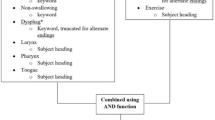Abstract
Cough remains refractory to medical treatment in approximately 20% of cases. Speech pathology intervention is a useful treatment option for patients with chronic cough that is refractory to treatment based on the anatomic diagnostic protocol. One of the reasons for this is that the larynx can be implicated in the pathogenesis of chronic refractory cough. There is an overlap in symptoms and clinical findings in patients with cough and those with laryngeal conditions such as paradoxical vocal fold movement. Furthermore, there is a high prevalence of voice symptoms in patients with chronic cough. Speech pathology intervention for cough comprises four components: (1) education, (2) strategies to control cough, (3) vocal hygiene training, and (4) psychoeducational counselling. The efficacy of speech pathology intervention has been examined in a single blind randomised control trial. In this trial 87% of patients in the treatment group improved, whereas 14% on the placebo group improved. Cough reflex sensitivity has also been shown to improve following speech pathology intervention for cough. This review outlines the potential mechanisms for improvement in cough, indicators for referral to speech pathology for cough, and exclusion criteria.



Similar content being viewed by others
References
Colton J, Casper J, Leonard R (2011) Understanding voice problems: a physiological perspective for diagnosis and treatment, 4th edn. Lippincott Williams & Wilkins, Baltimore
Ma W, Yu L, Wang Y, Li X, Lü H, Qiu Z (2009) Changes in health related quality of life and clinical implications in Chinese patients with chronic cough. Cough 5:7
Irwin R, Boulet L, Cloutier M et al (1998) Managing cough as a defence mechanism and as a symptom: a consensus report for the American College of Chest Physicians. Chest 114(2 Suppl Managing):133S–181S
Haque R, Usmani O, Barnes P (2005) Chronic idiopathic cough: a discrete clinical entity? Chest 127(5):1710–1713
Ryan N, Gibson P (2009) Characterization of laryngeal dysfunction in chronic persistent cough. Laryngoscope 119(4):640–645
Vertigan A, Theodoros D, Winkworth A, Gibson P (2007) Perceptual voice characteristics in chronic cough and paradoxical vocal fold movement. Folia Phoniatr Logop 59:256–267
Oates J, Russell A (1998) Learning voice analysis using a mult-media package: development and preliminary evaluation. J Voice 12(4):500–512
Vertigan A, Theodoros D, Gibson P, Winkworth A (2007) Voice and upper airway symptoms in people with chronic cough and paradoxical vocal fold movement. J Voice 21(3):361–383
Vertigan A, Gibson P (2011) Chronic refractory cough as a sensory neuropathy: evidence from a reinterpretation of cough triggers. J Voice 25(5):596–601
Blager F (2000) Paradoxical vocal fold movement: diagnosis and management. Curr Opin Otolaryngol Head Neck Surg 8:180–183
Vertigan A, Theodoros D, Winkworth A, Gibson P (2007) Chronic cough: a tutorial for speech language pathologists. J Med Speech Language Pathol 15:189–206
Mazzone SB, McLennan L, McGovern AE, Egan GF, Farrell MJ (2007) Representation of capscaisin evoked urge to cough in human brain using functional MRI. Am J Respir Crit Care Med 176(4):327–332
Fisher K, Ligon J, Sobecks J, Roxe D (2001) Phonatory effects of body fluid removal. J Speech Lang Hear Res 46:354–367
Verdolini K, Titze I, Druker D (1990) Changes in phonation threshold pressure with induced conditions of hydration. J Voice 4:142–151
Eccles R (2003) Placebo effects of antitussive treatments on cough associated with acute upper respiratory tract infection. In: Chung K, Widdicome J, Boushey H (eds) Cough: causes, mechanisms and therapy. Blackwell Publishing, Melbourne
Vertigan A, Theodoros D, Gibson P, Winkworth A (2006) Efficacy of speech pathology management for chronic cough: a randomised, single blind, placebo controlled trial of treatment efficacy. Thorax 61:1065–1069
Ryan N, Vertigan A, Bone S, Gibson P (2010) Cough reflex sensitivity improves with speech language pathology management of refractory chronic persistent cough. Cough 6:5
Murry T, Tabaee A, Aviv J (2004) Respiratory retraining of refractory cough and laryngopharyngeal reflux in patients with paradoxical vocal fold movement disorder. Laryngoscope 114(8):1341–1345
Murry T, Branski R, Yu K, Cukier-Blag S, Duflo S, Aviv J (2010) Laryngeal sensory deficits in patients with chronic cough and paradoxical vocal fold movement disorder. Laryngoscope 120:1576–1581
Gibson P, Chang A, Glasgow N et al (2010) CICADA: cough in children and adults: diagnosis and assessment. Australian cough guidelines summary statement. Med J Aust 192(5):265–271
Vertigan A, Gibson P, Theodoros D, Winkworth A, Borgas T, Reid C (2006) Involuntary glottal closure during inspiration in muscle tension dysphonia. Laryngoscope 116(4):643–649
Conflict of interest
None.
Author information
Authors and Affiliations
Corresponding author
Rights and permissions
About this article
Cite this article
Vertigan, A.E., Gibson, P.G. The Role of Speech Pathology in the Management of Patients with Chronic Refractory Cough. Lung 190, 35–40 (2012). https://doi.org/10.1007/s00408-011-9333-0
Received:
Accepted:
Published:
Issue Date:
DOI: https://doi.org/10.1007/s00408-011-9333-0




